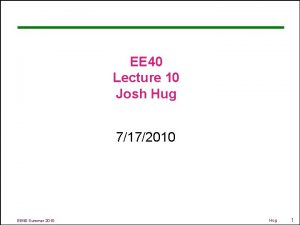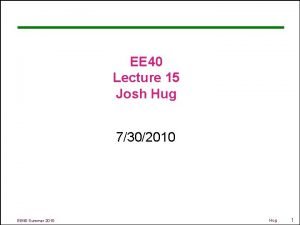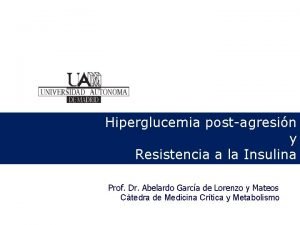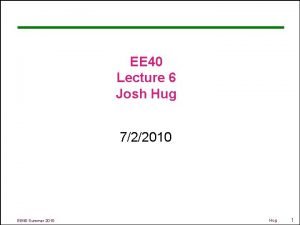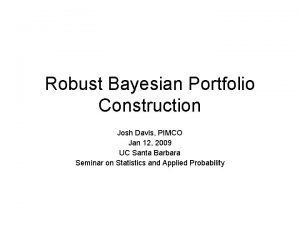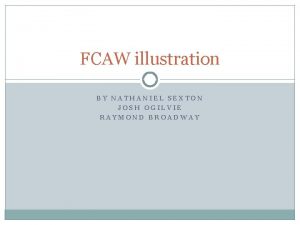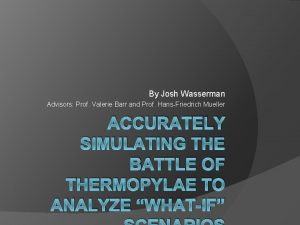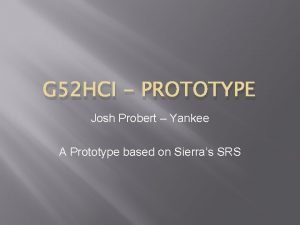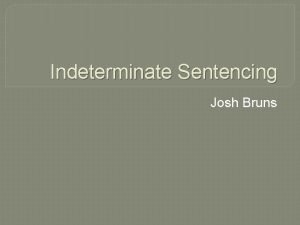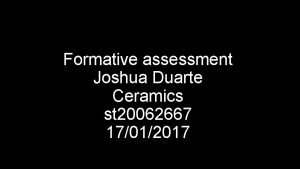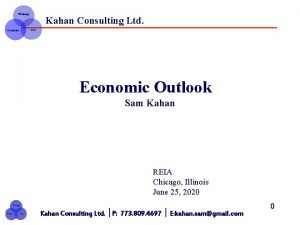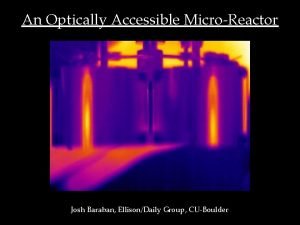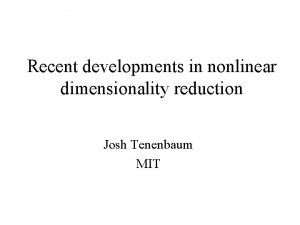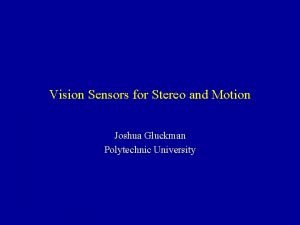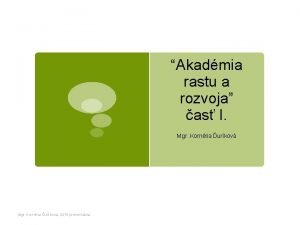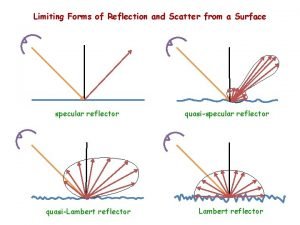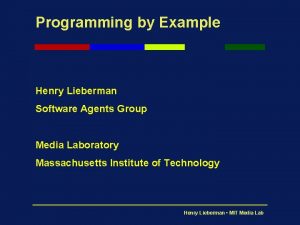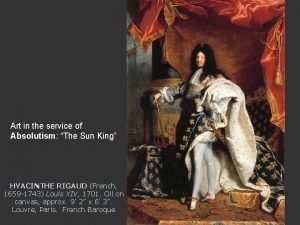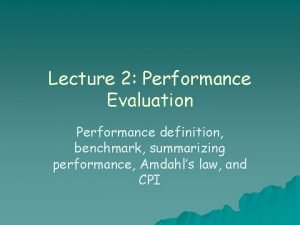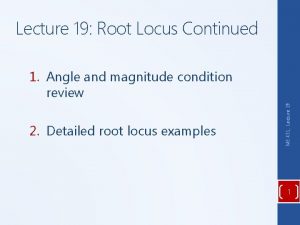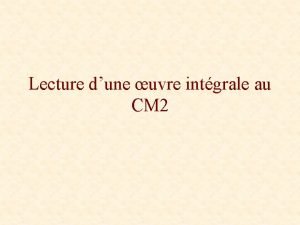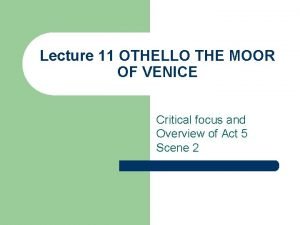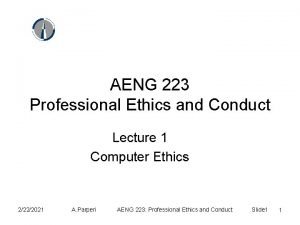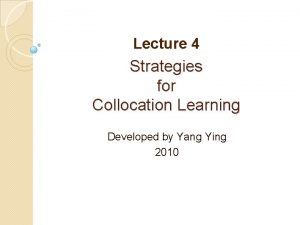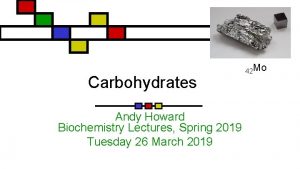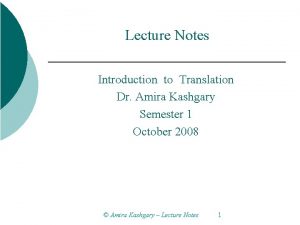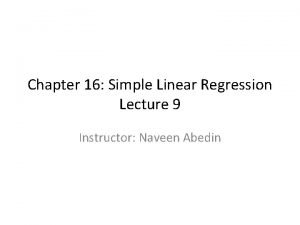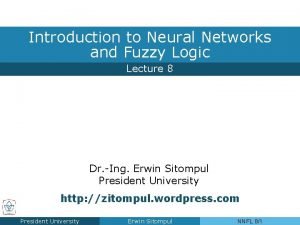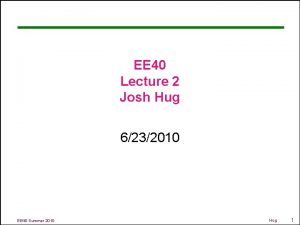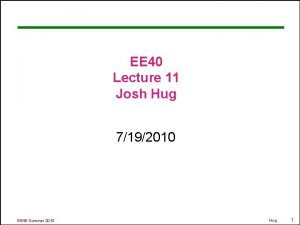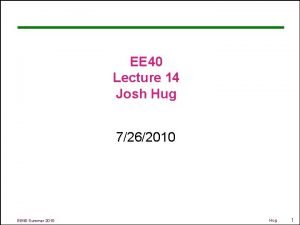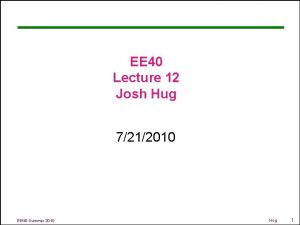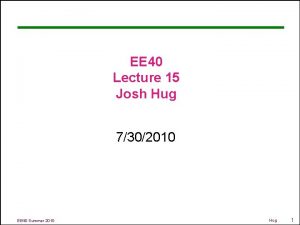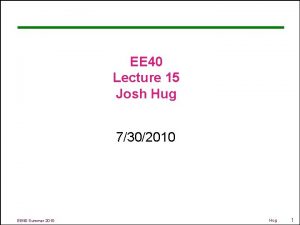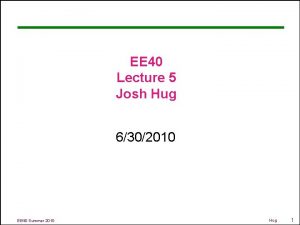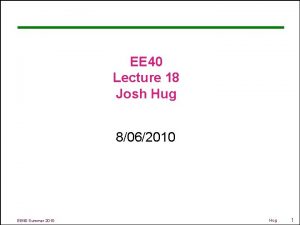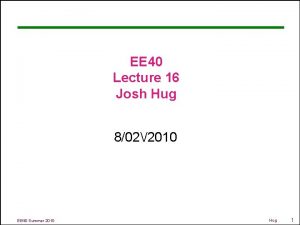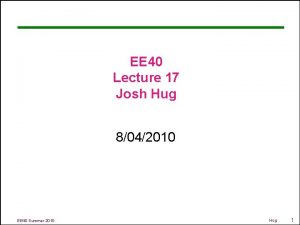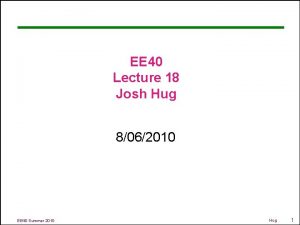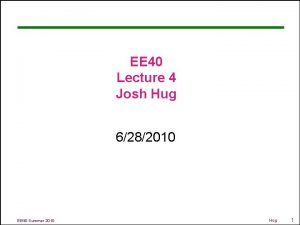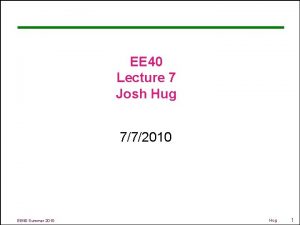EE 40 Lecture 2 Josh Hug 6232010 EE
























































































- Slides: 88

EE 40 Lecture 2 Josh Hug 6/23/2010 EE 40 Summer 2010 Hug 1

Logistical Changes and Notes • Friday Lunch is now Monday lunch (starting next Monday) – Email me by Saturday evening if you’d like to come: JHUG aat eecs. berkeley. edu • My office hours will be Wednesday and Friday, 11: 00 -12: 00, room TBA • Google calendar with important dates now online • Did anybody not get my email sent out Monday (that said no discussion yesterday)? • Will curate the reading a little more carefully next time EE 40 Summer 2010 Hug 2

Lab/HW Deadlines and Dates • • Discussions start Friday Labs start next Tuesday HW 0 Due Today Homework 1 will be posted by 3 PM, due Friday at 5 PM • Tuesday homeworks now due at 2 PM, not 5 PM in Cory 240 HW box EE 40 Summer 2010 Hug 3

Summary From Last Time • Current = rate of charge flow • Voltage = energy per unit charge created by charge separation • Power = energy per unit time • Ideal Basic Circuit Element – 2 -terminal component that cannot be sub-divided – Described mathematically in terms of its terminal voltage and current • Circuit Schematics – Networks of ideal basic circuit elements – Equivalent to a set of algebraic equations – Solution provides voltage and current through all of the circuit EE 40 Summerelements 2010 Hug 4

Heating Elements • Last time we posed a question: – Given a fixed voltage, should we pick a thick or thin wire to maximize heat output – Note that resistance decreases with wire radius • Most of you said that we’d want a thin wire to maximize heat output, why is that? – Believed that low resistance wire would give the most heat? – Didn’t believe me that thick wire has low resistance? – General intuition? EE 40 Summer 2010 Hug 5

Intuitive Answer • I blasted through some equations and said “thicker is better, Q. E. D. ”, but I’m not sure you guys were convinced, so here’s another view • You can think of a big thick wire as a bunch of small wires connected to a source – The thicker the wire, the more little wires – Since they are all connected directly to the source, they all have same voltage and current and hence power – Adding more wires gives us more total current flow (same voltage), and hence more power EE 40 Summer 2010 Hug 6

Then Why Don’t Toasters and Ovens Have Thicker Elements? • Thicker elements mean hotter elements – Will ultimately reach higher max temperature – Will get to maximum faster [see message board after 6 or 7 PM tonight for why] • Last time, you guys asked “Well if thickness gives you more heat, why aren’t toaster elements thicker? ” • The answer is most likely: – More burned toast. Nobody likes burned toast. EE 40 Summer 2010 Hug 7

Toaster Element Design Goals • Make heating element that can: – – – Can reach a high temperature, but not too high Can reach that temperature quickly Isn’t quickly oxidized into oblivion by high temperature Doesn’t cost very much money Will not melt at desired temperature • Nichrome is a typical metal alloy in elements: – Low oxidation – High resistance (so normal gauge wire will not draw too much power and get too hot) • Size was tweaked to attain desired temperature EE 40 Summer 2010 Hug 8

Continue the Discussion on BSpace • Let’s get working on some more complicated circuits than this: EE 40 Summer 2010 Hug 9

Topic 2 Setting Up and Solving Resistive Circuit Models EE 40 Summer 2010 Hug 10

Circuit Schematics • Many circuit elements can be approximated as simple ideal two terminal devices or ideal basic circuit elements • These elements can be combined into circuit schematics • Circuit schematics can be converted into algebraic equations • These algebraic equations can be solved, giving voltage and current through any element of the circuit EE 40 Summer 2010 Hug 11

Today • We’ll enumerate the types of ideal basic circuit elements • We’ll more carefully define a circuit schematic • We’ll discuss some basic techniques for analyzing circuit schematics – Kirchoff’s voltage and current laws – Current and voltage divider – Node voltage method EE 40 Summer 2010 Hug 12

Circuit Elements • There are 5 ideal basic circuit elements (in our course): – – – voltage source current source resistor inductor capacitor active elements, capable of generating electric energy passive elements, incapable of generating electric energy • Many practical systems can be modeled with just sources and resistors • The basic analytical techniques for solving circuits with inductors and capacitors are the same as those for resistive circuits EE 40 Summer 2010 Hug 13

Electrical Sources • An electrical source is a device that is capable of converting non-electric energy to electric energy and vice versa. Examples: – battery: chemical electric – dynamo (generator/motor): mechanical electric Electrical sources can either deliver or absorb power EE 40 Summer 2010 Hug 14

The Big Three i vs EE 40 Summer 2010 + _ v v is Constant current, unknown voltage i R Hug 15

Circuit Schematics • A circuit schematic is a diagram showing a set of interconnected circuit elements, e. g. – Voltage sources – Current sources – Resistors • Each element in the circuit being modeled is represented by a symbol • Lines connect the symbols, which you can think of as representing zero resistance wires EE 40 Summer 2010 Hug 16

Terminology: Nodes and Branches Node: A point where two or more circuit elements are connected – entire wire Can also think of as the “vertices” of our schematic EE 40 Summer 2010 Hug 17

Terminology: Nodes and Branches Branch: A path that connects exactly two nodes Branch Not a branch EE 40 Summer 2010 Hug 18

Terminology: Loops • A loop is formed by tracing a closed path in a circuit through selected basic circuit elements without passing through any intermediate node more than once • Example: (# nodes, # branches, # loops) 6 nodes 7 branches 3 loops EE 40 Summer 2010 Hug 19

Kirchhoff’s Laws • Kirchhoff’s Current Law (KCL): – The algebraic sum of all the currents at any node in a circuit equals zero. – “What goes in, must come out” – Basically, law of charge conservation 10 m. A 40 m. A 50 m. A 20 m. A EE 40 Summer 2010 Hug 20

Using Kirchhoff’s Current Law (KCL) Often we’re considering unknown currents and only have reference directions: i 2 i 3 i 1 i 4 i 1+i 2=i 3+i 4 or i 1+i 2 -i 3 -i 4=0 or -i 1 -i 2+i 3+i 4=0 • Use reference directions to determine whether reference currents are said to be “entering” or “leaving” the node – with no concern about actual current directions EE 40 Summer 2010 Hug 21

KCL Example -10 m. A 5+(-10)=15+i 5 m. A 15 m. A EE 40 Summer 2010 i i=10 m. A Hug 22

A Major Implication of KCL • KCL tells us that all of the elements along a single uninterrupted* path carry the same current • We say these elements are connected in series. Current entering node = Current leaving node i 1 = i 2 *: To be precise, by uninterrupted path I mean all branches along the path connected EXACTLY two nodes EE 40 Summer 2010 Hug 23

Generalization of KCL • The sum of currents entering/leaving a closed surface is zero. Circuit branches can be inside this surface, i. e. the surface can enclose more than one node! i 2 i 3 This could be a big chunk of a i 4 circuit, e. g. a i 1 “black box” EE 40 Summer 2010 Hug 24

Generalized KCL Examples 50 m. A 5 m. A i 2 m. A i 50 m. A 7 m. A EE 40 Summer 2010 Hug 25

Kirchhoff’s Laws • Kirchhoff’s Voltage Law (KVL): – The algebraic sum of all the voltages around any loop in a circuit equals zero. – “What goes up, must come down” + 20 V – + 50 V – + 80 V – – EE 40 Summer 2010 80=20+50+10 10 V + Hug 26

A Major Implication of KVL • KVL tells us that any set of elements which are connected at both ends carry the same voltage. • We say these elements are connected in parallel. + va _ + vb _ Applying KVL, we have that: vb – va = 0 vb = va EE 40 Summer 2010 Hug 27

KVL Example Three closed paths: 1 + va b + vb - + v 2 v 3 + a 2 c + vc 3 Path 1: Va=V 2+Vb Path 2: Vb+V 3=Vc Path 3: Va+V 3=V 2+Vc EE 40 Summer 2010 If you want a mechanical rule: If you hit a – first, LHS If you hit a + first, RHS LHS is left hand side Hug 28

An Underlying Assumption of KVL • No time-varying magnetic flux through the loop Otherwise, there would be an induced voltage (Faraday’s Law) Voltage around a loop would sum to a nonzero value • Note: Antennas are designed to “pick up” electromagnetic waves; “regular circuits” often do so undesirably. + How do we deal with antennas (EECS 117 A)? Include a voltage source as the circuit representation of the induced voltage or “noise”. (Use a lumped model rather than a distributed (wave) model. ) EE 40 Summer 2010 Hug 29

Mini-Summary • KCL tells us that all elements on an uninterrupted path have the same current. – We say they are “in series” • KVL tells us that a set of elements whose terminals are connected at the same two nodes have the same voltage – We say they are “in parallel” EE 40 Summer 2010 Hug 30

Nonsense Schematics • Just like equations, it is possible to write nonsense schematics: – 1=7 • A schematic is nonsense if it violates KVL or KCL 1 V EE 40 Summer 2010 7 V Hug 31

Verifying KCL and KVL 20 A 5 V Is this schematic valid? Yes How much power is consumed/provided by each source? Voltage source: PV=5 V*20 A =100 W (consumed) Current source: PI=-20 A*5 V=100 W (provided) EE 40 Summer 2010 Hug 32

Verifying KCL and KVL 10 A 100 V 5 A 5 A KCL: KVL: Is this valid? Yes No contradiction Top left node: Top right node: Bottom node: I 100=10 A 10 A=5 A+5 A=I 100 Left loop: 100 V=V 10+V 5 Right loop: V 5=V 5 Big loop: 100 V=V 10+V 5 EE 40 Summer 2010 No contradiction Hug 33

Verifying KCL and KVL 10 A 100 V 5 A 5 A Is this valid? Yes KCL: Top left node: I 100=10 A KVL: Left loop: 100 V=V 10+V 5 2 equations 3 unknowns So what are V 10 and V 5? Whatever we want that sums to 100 V Multiple circuit solutions EE 40 Summer 2010 Hug 34

i. Clicker #1 • Are these interconnections permissible? A. Both are bad B. Left is ok, right is bad C. Left is bad, right is ok D. Both are ok EE 40 Summer 2010 Hug 35

On to Solving Circuits • Next we’ll talk about a general method for solving circuits – The book calls this the “basic method” – It’s a naïve way of solving circuits, and is way more work than you need • Basic idea is to write every equation you can think of to write, then solve – However, it will build up our intuition for solving circuits, so let’s start here EE 40 Summer 2010 Hug 36

Solving Circuits (naïve way) • Label every branch with a reference voltage and current – If two branches are in parallel, share voltage label – If in series, share same current label • For each branch: – Write Ohm’s law if resistor – Get branch voltage “for free” if known voltage source – Get branch current “for free” if known current source EE 40 Summer 2010 Hug 37

Solving Circuits (naïve way) • Label every branch with a reference voltage and current – If two branches are in parallel, share voltage label – If in series, share same current label • For each branch: – Write Ohm’s law if resistor – Get branch voltage “for free” if known voltage source – Get branch current “for free” if known current source • For each node touching at least 2 reference currents: – Write KCL – gives reference current relationships – Can omit nodes which contain no new currents • For each loop: – Write KVL – gives reference voltage relationships – Can omit loops which contain no new voltages EE 40 Summer 2010 Could also call this the “kitchen sink” approach Hug 38

Example: KCL and KVL applied to circuits • Find the current through the resistor • Use KVL, we see we can write: V 1=VR+V 2 VR 20Ω + + V 1 5 V IR + 3 V V 2 V 1=5 V V 2=3 V IR=VR/20Ω 4 equations 4 “unknowns” • Now solving, we have: 5 V=VR+3 V 2 V=VR IR=2 V/20Ω=0. 1 Amps Note: We had no node touching 2 ref currents, so no reference current relationships EE 40 Summer 2010 Hug 39

Bigger example + V 30 + + V 1 V 80 ia ig Branches: + V 1=ia*80Ω vg V 30=1. 6 A*30Ω Vg=1. 6 A*90 Ω Two nodes which touch two different reference currents: ig=ia+1. 6=ig [no new currents] Three loops, but only one needed to touch all voltages: V 1=V 30+Vg V 30=48 V Vg=144 V V 1=192 V EE 40 Summer 2010 ia=2. 4 A ig=4 A 5 equations 5 unknowns Hug 40

i. Clicker #2 • How many KCL and KVL equations will we need to cover every branch voltage and branch current? A. 2 KVL loops, 2 KCL nodes B. 3 KVL loops, 2 KCL nodes C. 2 KVL loops, 4 KCL nodes D. 3 KVL loops, 4 KCL nodes E. None of these I am the worst 2 KVL, 1 KCL EE 40 Summer 2010 Hug 41

i. Clicker Proof • How many KCL and KVL equations will we need to cover every branch voltage and branch current? 2 KVL, 1 KCL Top node: I 1=I 2+I 3 Bottom node: I 3+I 2=I 1 EE 40 Summer 2010 I 2 I 1 I 3 Hug 42

There are better ways to solve circuits • The kitchen sink method works, but we can do better – Current divider – Voltage divider – Lumping series and parallel elements together (circuit simplification) – Node voltage EE 40 Summer 2010 Hug 43

Voltage Divider • Voltage divider – Special way to handle N resistors in series – Tells you how much voltage each resistor consumes – Given a set of N resistors R 1, …, Rk, …, RN in series with total voltage drop V, the voltage through Rk is given by Or more compactly: EE 40 Summer 2010 Can prove with kitchen sink method (see page 78) Hug 44

Voltage Divider Example 5Ω 85Ω 100 V 10Ω And likewise for other resistors EE 40 Summer 2010 Hug 45

Current Divider • Current divider – Special way to handle N resistors in parallel – Tells you how much current each resistor consumes – Given a set of N resistors R 1, …, Rk, …, RN in parallel with total current I the current through Rk is given by Where: We call Gp the conductance of a resistor, in units of Mhos (℧) -Sadly, not units of Shidnevacs ( ) Can prove with kitchen sink method (see http: //www. elsevierdirect. com/companions/9781558607354/casestudies/02~Chapter_2/Example_2_20. pdf ) EE 40 Summer 2010 Hug 46

Current Divider Example 5Ω 10Ω Conductances are: 5Ω 1/5Ω=0. 2℧ 1/10Ω=0. 1℧ 1/5Ω=0. 2℧ 1/2Ω=0. 5℧ 2Ω 20 A Sum of conductances is 1℧ (convenient!) Current through 5Ω resistor is: EE 40 Summer 2010 Hug 47

Circuit Simplification • Next we’ll talk about some tricks for combining multiple circuit elements into a single element • Many elements in series One single element • Many elements in parallel One single element EE 40 Summer 2010 Hug 48

Circuit Simplification Example Combining Voltage Sources • KVL trivially shows voltage across resistor is 15 V • Can form equivalent circuit as long as we don’t care about individual source behavior – For example, if we want power provided by each source, we have to look at the original circuit 5 V 9 V 15 V 1 V 15Ω EE 40 Summer 2010 15Ω Hug 49

Example – Combining Resistances • Can use kitchen sink method or voltage divider method to show that current provided by the source is equivalent in the two circuits below 5Ω 11Ω 20Ω 4Ω EE 40 Summer 2010 Hug 50

Source Combinations • Voltage sources in series combine additively • Voltage sources in parallel – This is like crossing the streams – “Don’t cross the streams” – Mathematically nonsensical if the voltage sources are not exactly equal • Current sources in parallel combine additively • Current sources in series is bad if not the same current EE 40 Summer 2010 Hug 51

Resistor Combinations • Resistors in series combine additively • Resistors in parallel combine weirdly – More natural with conductance: • N resistors in parallel with the same resistance R have equivalent resistance Req=R/N EE 40 Summer 2010 Hug 52

Algorithm For Solving By Combining Circuit Elements • Check circuit diagram – If two or more elements of same type in series • Combine using series rules – If two or more elements of same type in parallel • Combine using parallel rules • If we combined anything, go back to • If not, then solve using appropriate method (kitchen sink if complicated, divider rule if possible) EE 40 Summer 2010 Hug 53

i. Clicker #3: Using Equivalent Resistances Are there any circuit elements in parallel? Example: Find I I 15 30 V + 15 10 40 A. I=32. 94 A B. I=2 A C. I=1 A EE 40 Summer 2010 6 50 Are there any circuit elements in parallel? D. I=0. 22 A E. I=13. 35 A Hug 54

Using Equivalent Resistances Are there any circuit elements in parallel? Example: Find I I 15 30 V + 15 6 10 40 50 No! Are there any circuit elements in parallel? Yes! EE 40 Summer 2010 Hug 55

Using Equivalent Resistances Are there any circuit elements in parallel? Example: Find I I 30 6 30 V + 10 40 50 Yes! Are there any circuit elements in parallel? Yes! EE 40 Summer 2010 Hug 56

Using Equivalent Resistances Are there any circuit elements in parallel? Example: Find I I 30 6 30 V + 50 50 No! Are there any circuit elements in parallel? Yes! EE 40 Summer 2010 Hug 57

Using Equivalent Resistances Are there any circuit elements in parallel? Example: Find I I 5 30 V + No! 50 50 Are there any circuit elements in parallel? Yes! EE 40 Summer 2010 Hug 58

Using Equivalent Resistances Are there any circuit elements in parallel? Example: Find I I 5 30 V + 25 No! Are there any circuit elements in parallel? No! EE 40 Summer 2010 Hug 59

Using Equivalent Resistances Are there any circuit elements in parallel? Example: Find I I No! 30 V + 30 Are there any circuit elements in parallel? No! I=30 V/30Ω=1 A EE 40 Summer 2010 Hug 60

Working Backwards • Assume we’ve combined several elements to understand large scale behavior • Now suppose we want to know something about one of those circuit elements that we’ve combined – For example, current through a resistor that has been combined into equivalent resistance • We undo our combinations step by step – At each step, use voltage and current divider tricks – Only undo enough so that we get the data we want EE 40 Summer 2010 Hug 61

Working Backwards Example • Suppose we want to know the voltage across the 40Ω Resistor I 15 30 V + 15 10 40 EE 40 Summer 2010 6 50 Hug 62

Using Equivalent Resistances I=1 Amp Starting from here… I 30 V EE 40 Summer 2010 + 30 Hug 63

Using Equivalent Resistances We back up one step… V 25=I*25Ω=25 V I=1 Amp I 5 30 V EE 40 Summer 2010 + 25 + V 25 Then another… Hug 64

Using Equivalent Resistances We back up one step… V 25=I*25Ω=25 V I=1 Amp I 5 30 V + 50 Then another… + 50 EE 40 Summer 2010 V 25 Then one more… Hug 65

Using Equivalent Resistances We back up one step… V 25=I*25Ω=25 V I=1 Amp I 5 30 V + 10 40 Then another… + 50 V 25 Then one more… Now we can use the voltage divider rule, and get EE 40 Summer 2010 Hug 66

Using Equivalent Resistances We back up one step… V 25=I*25Ω=25 V I=1 Amp I 15 + 15 6 Then one more… 10 40 Then another… 50 Now we can use the voltage divider rule, and get EE 40 Summer 2010 Hug 67

Equivalent Resistance Between Two Terminals • We often want to find the equivalent resistance of a network of resistors with no source attached 10Ω 10Ω Req • Tells us the resistance that a hypothetical source would “see” if it were connected • e. g. In this example, the resistance that provides the correct source current EE 40 Summer 2010 Hug 68

Equivalent Resistance Between Two Terminals • Pretend there is a source of some kind between the circuits • Perform the parallel/series combination algorithm as before 10Ω 10Ω 10Ω 5Ω 25Ω 10Ω EE 40 Summer 2010 Hug 69

Can Pick Other Pairs of Terminals 10Ω 10Ω These resistors do nothing (except maybe confuse us) 5Ω EE 40 Summer 2010 Combine these parallel resistors Hug 70

There are better ways to solve circuits • The kitchen sink method works, but we can do better – Current divider – Voltage divider – Lumping series and parallel elements together (circuit simplification) – Node voltage EE 40 Summer 2010 Hug 71

The Node Voltage Technique • We’ll next talk about a general technique that will let you convert a circuit schematic with N nodes into a set of N-1 equations • These equations will allow you to solve for every single voltage and current • Works on any circuit, linear or nonlinear! • Much more efficient than the kitchen sink EE 40 Summer 2010 Hug 72

Definition: Node Voltage and Ground Node • Remember that voltages are always defined in terms of TWO points in a circuit • It is convenient to label one node in our circuit the “Ground Node” – Any node can be “ground”, it doesn’t matter which one you pick • Once we have chosen a ground node, we say that each node has a “node voltage”, which is the voltage between that node and the arbitrary ground node • Gives each node a universal single valued voltage level EE 40 Summer 2010 Hug 73

Node Voltage Example a 5Ω + + 10Ω 200 V d b + 85Ω c V 5=10 V V 85=170 V V 10=20 V • Pick a ground, say the bottom left node. • Label nodes a, b, c, d. Node voltages are: – – Vd=voltage between node d and d=0 V Vc=voltage between node c and d=V 10=20 V Vb=voltage between node b and d=V 85+V 10=190 V Va=voltage between node a and d=200 V EE 40 Summer 2010 Hug 74

i. Clicker #4: Node Voltages 5Ω a + 200 V d A. B. C. D. 200 V 20 V 160 V 180 V EE 40 Summer 2010 + 10Ω b + 85Ω c V 5=10 V V 85=170 V V 10=20 V What is Va? Va=V 5+V 85=180 V Hug 75

Relationship: Node and Branch Voltages • Node voltages are useful because: – The branch voltage across a circuit element is simply the difference between the node voltages at its terminals – It is easier to find node voltages than branch voltages Example: 5Ω Vd=V a b Vc=20 V + + Vb=190 V 85Ω Va=200 V d + c V 85=Vb-Vc=190 V-20 V=170 V EE 40 Summer 2010 Hug 76

Why are Node Voltages Easier to Find? a b 4 A • KCL is easy to write in terms of node voltages • For example, at node a: • 4 A=Va/80Ω+(Va-Vb)/30Ω • And at node b: • (Vb-Va)/30Ω=Vb/90Ω • Well look, two equations, two unknowns. We’re done. • Better than 5 equations, 5 unknowns with kitchen sink method Hug EE 40 Summer 2010 77

(Almost) The Node Voltage Method • Assign a ground node • For every node except the ground node, write the equation given by KCL in terms of the node voltages • Be very careful about reference directions • This gives you a set of N-1 linearly independent algebraic equations in N-1 unknowns • Solvable using whatever technique you choose EE 40 Summer 2010 Hug 78

What about Voltage Sources? • Suppose we have the circuit below a 5Ω b 85Ω 200 V d 10Ω c • When we try to write KCL at node a, what happens? • How do we get around this? – Write fixed node voltage relationship: Va=Vd+200 EE 40 Summer 2010 Hug 79

Full Node Voltage Method • Assign a ground node • For every node (except the ground node): – If there is no voltage source connected to that node, then write the equation given by KCL in terms of the node voltages – If there is a voltage source connecting two nodes, write down the simple equation giving the difference between the node voltages – Be very careful about reference directions (comes with practice) • This gives you a set of N-1 linearly independent algebraic equations in N-1 unknowns • Solvable using whatever technique you choose EE 40 Summer 2010 More Examples Next Time! Hug 80

Next Class • Node voltage practice and examples • Why we are bothering to understand so deeply the intricacies of purely resistive networks – Things we can build other than the most complicated possible toaster • How we actually go about measuring voltages and currents • More circuit tricks – Superposition – Source transformations EE 40 Summer 2010 Hug 81

Quick i. Clicker Question • How was my pacing today? A. B. C. D. E. Way too slow A little too slow Pretty good Too fast Way too fast EE 40 Summer 2010 Hug 82

Extra Slides EE 40 Summer 2010 Hug 83

Summary (part one) • There are five basic circuit elements – – – Voltage Sources Current Sources Resistors Capacitors Inductors • Circuit schematics are a set of interconnect ideal basic circuit elements • A connection point between elements is a node, and a path that connects two nodes is a branch • A loop is a path around a circuit which starts and ends at the same node without going through any circuit element twice EE 40 Summer 2010 Hug 84

Summary (part two) • Kirchoff’s current law states that the sum of the currents entering a node is zero • Kirchoff’s voltage law states that the sum of the voltages around a loop is zero • From these laws, we can derive rules for combining multiple sources or resistors into a single equivalent source or resistor • The current and voltage divider rules are simple tricks to solve simple circuits • The node voltage technique provides a general framework for solving any circuit using the elements we’ve used so far EE 40 Summer 2010 Hug 85

Short Circuit and Open Circuit Wire (“short circuit”): • R = 0 no voltage difference exists (all points on the wire at the same potential) • Current can flow, as determined by the circuit Air (“open circuit”): • R = no current flows • Voltage difference can exist, as determined by the circuit EE 40 Summer 2010 Hug 86

Ideal Voltage Source • Circuit element that maintains a prescribed voltage across its terminals, regardless of the current flowing in those terminals. – Voltage is known, but current is determined by the circuit to which the source is connected. • The voltage can be either independent or dependent on a voltage or current elsewhere in the circuit, and can be constant or time-varying. Circuit symbols: vs + _ independent EE 40 Summer 2010 vs=m vx +_ v s= r i x + _ voltage-controlled current-controlled Hug 87

Ideal Current Source • Circuit element that maintains a prescribed current through its terminals, regardless of the voltage across those terminals. – Current is known, but voltage is determined by the circuit to which the source is connected. • The current can be either independent or dependent on a voltage or current elsewhere in the circuit, and can be constant or time-varying. Circuit symbols: is independent EE 40 Summer 2010 i s= a v x i s= b i x voltage-controlled current-controlled Hug 88
 Josh hug
Josh hug Josh hug
Josh hug 01:640:244 lecture notes - lecture 15: plat, idah, farad
01:640:244 lecture notes - lecture 15: plat, idah, farad Fasthug
Fasthug Stimulus diffusion definition
Stimulus diffusion definition Mga pagbati sa wikang filipino
Mga pagbati sa wikang filipino Mandt training outline
Mandt training outline Rank size rule cities
Rank size rule cities Smile simple past tense
Smile simple past tense Embiyax su hug
Embiyax su hug Remote sensing ap hug
Remote sensing ap hug Rebecca hug
Rebecca hug Gimnazija hug
Gimnazija hug The group of verbs
The group of verbs Proxy fight
Proxy fight Sprawl aphg
Sprawl aphg Josh davis pimco
Josh davis pimco Josh ogilvie
Josh ogilvie Josh wasserman
Josh wasserman Josh probert
Josh probert Josh bachynski
Josh bachynski Docker legacy applications
Docker legacy applications Josh tenebaum
Josh tenebaum Josh burk
Josh burk Josh tenenbaum
Josh tenenbaum Szuta community high school
Szuta community high school Josh bostick
Josh bostick Josh bruns
Josh bruns Sue harker
Sue harker Josh duarte pottery
Josh duarte pottery Josh kahan
Josh kahan Josh farley
Josh farley Josh baraban
Josh baraban Josh davies work ethic
Josh davies work ethic Josh christianson
Josh christianson Josh barron medication error
Josh barron medication error Josh cullen
Josh cullen Just like josh gibson comprehension questions
Just like josh gibson comprehension questions Who does josh lieberman represent
Who does josh lieberman represent Josh tenenbaum
Josh tenenbaum Josh browar
Josh browar Josh gluckman
Josh gluckman Josh iche
Josh iche Josh tenenberg
Josh tenenberg Josh kahan
Josh kahan Josh portman
Josh portman A runner covers the last straight stretch
A runner covers the last straight stretch The crossover josh character traits
The crossover josh character traits Jasmine richardsom
Jasmine richardsom Josh waitzkin wife
Josh waitzkin wife Josh dempsey georgia
Josh dempsey georgia Statquest josh starmer
Statquest josh starmer Josh wurman
Josh wurman Josh kohut
Josh kohut Josh rosenau
Josh rosenau Josh benaloh
Josh benaloh Dr. josh laxton
Dr. josh laxton Henry
Henry Josh brownlow
Josh brownlow Robinson crusoe the spaniard
Robinson crusoe the spaniard Josh poulson
Josh poulson Share learn teach
Share learn teach Noms score spine
Noms score spine Josh tatlor
Josh tatlor 5 why washington monument
5 why washington monument Josh wright sheffield
Josh wright sheffield Philosopher giving a lecture on the orrery
Philosopher giving a lecture on the orrery Data visualization lecture
Data visualization lecture Wbb99
Wbb99 Contemporary issues in operations management ppt
Contemporary issues in operations management ppt Advanced operating system notes
Advanced operating system notes Parallel and distributed computing lecture notes
Parallel and distributed computing lecture notes Lecture 19
Lecture 19 Tirez pas sur le scarabée résumé complet
Tirez pas sur le scarabée résumé complet Bipolar junction transistor lecture notes
Bipolar junction transistor lecture notes Othello lecture
Othello lecture Lecture à l'unisson
Lecture à l'unisson Professor green lecture 1
Professor green lecture 1 What is plagiarism
What is plagiarism Natural language processing nlp - theory lecture
Natural language processing nlp - theory lecture Conduct lecture
Conduct lecture Exhibition collocation
Exhibition collocation Carbohydrates biochemistry lecture
Carbohydrates biochemistry lecture Computer aided drug design lecture notes
Computer aided drug design lecture notes Translation studies lecture notes
Translation studies lecture notes Linux lecture
Linux lecture Linear regression lecture
Linear regression lecture Image processing lecture notes
Image processing lecture notes Membership function fuzzy logic
Membership function fuzzy logic
